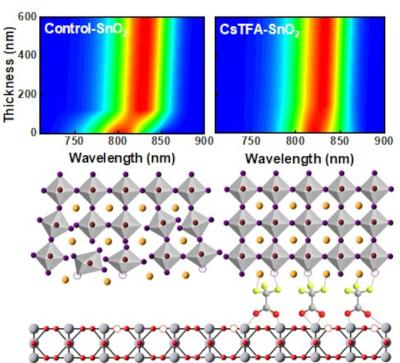BusinessKorea reports that researchers at the Ulsan National Institute of Science and Technology (UNIST) have significantly improved the efficiency and stability of perovskite solar cells by addressing defect issues.
Schematic of perovskite crystallinity changes and thickness-based photoluminescence analysis through the introduction of bidirectional tuning molecules. Source: BusinessKorea, UNIST
The UNIST team announced that a joint research team, led by Professors Kim Jin-young and Kim Dong-seok from the Department of Energy and Chemical Engineering, and Professor Lee Geun-sik from the Department of Chemistry, successfully introduced bidirectional tuning molecules between the perovskite photoactive layer and the electron transport layer.
The commercialization of perovskite solar cells has been hindered by various defect issues. To address these defects, the research team inserted a special ion, trifluoroacetate (TFA-), between the perovskite and the electron transport layer, which is a tin oxide thin film. The carboxylate group (-COO-) of TFA- firmly attached to the tin oxide, stabilizing the structure. Simultaneously, the –CF3 group effectively reduced defects through bidirectional tuning molecules that interact with the perovskite layer.
The research team successfully controlled the irregular structure of the perovskite thin film and significantly improved the charge transport characteristics. Solar cells produced using this technology recorded a high efficiency of 25.60% and maintained excellent stability even under prolonged light exposure. The research findings were published in the online journal 'Energy & Environmental Science' in July.
Professor Kim Dong-seok stated: "We have established a crucial breakthrough in overcoming the lower defects of perovskite thin films," adding, "This achievement will further enhance the commercial potential of perovskite solar cells."




